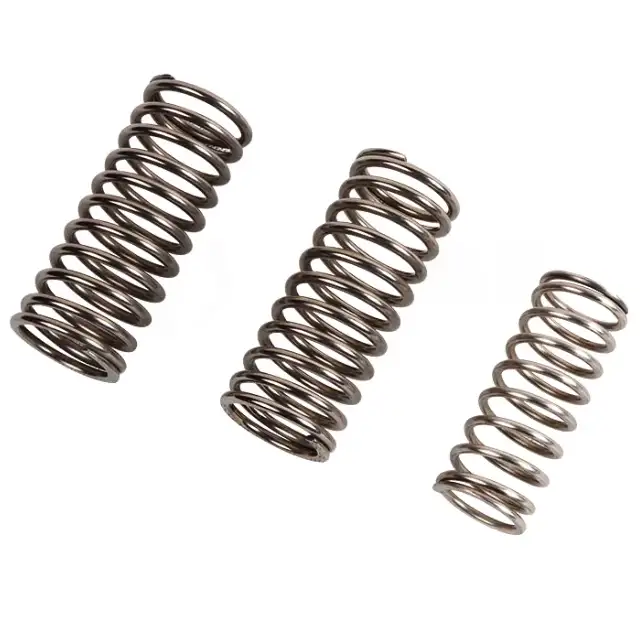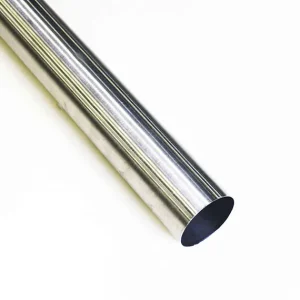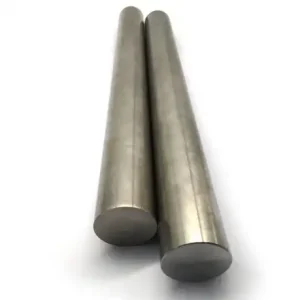Monel alloy 400 springs are the most versatile and reliable components in demanding industrial environments. These nickel-copper alloy springs excel in marine applications, chemical processing, and high-temperature operations where standard materials fail. After decades of metallurgical research and practical applications, we can confidently state that Monel 400 springs represent the optimal balance between corrosion resistance, mechanical strength, and cost-effectiveness for specialized industrial applications.
What is Monel Alloy 400 Spring?
Monel alloy 400 springs are precision-engineered elastic components manufactured from a solid-solution nickel-copper alloy containing approximately 67% nickel and 30% copper. We classify this material as UNS N04400, representing one of the most commercially successful nickel alloys in modern metallurgy.
The unique atomic structure of Monel 400 creates exceptional resistance to seawater, hydrofluoric acid, and numerous organic compounds. When formed into spring configurations, this alloy maintains its superior corrosion characteristics while providing reliable elastic performance across temperature ranges from -196°C to 480°C.
These springs demonstrate remarkable durability in environments where stainless steel and carbon steel components experience rapid degradation. The face-centered cubic crystal structure ensures consistent mechanical properties throughout the operational temperature range, making these components ideal for critical applications in marine engineering, chemical processing, and aerospace systems.
What is the Chemical Composition of Monel Alloy 400 Spring?
Understanding the precise chemical composition is crucial for predicting performance characteristics and compatibility with specific environments. We present the standardized composition requirements:
| Element | Weight Percentage | Role in Alloy Performance |
|---|---|---|
| Nickel (Ni) | 63.0 - 70.0% | Primary matrix element, corrosion resistance |
| Copper (Cu) | 28.0 - 34.0% | Solid solution strengthening, conductivity |
| Iron (Fe) | 2.5% max | Strengthening agent, magnetic properties |
| Manganese (Mn) | 2.0% max | Deoxidizer, sulfide shape control |
| Carbon (C) | 0.30% max | Carbide formation, hardening |
| Silicon (Si) | 0.50% max | Deoxidizer, fluidity improvement |
| Sulfur (S) | 0.024% max | Controlled for machinability |
The nickel-copper solid solution forms the foundation of this alloy's exceptional properties. We observe that the high nickel content provides outstanding resistance to reducing environments, while copper enhances ductility and thermal conductivity.
What are the Mechanical Properties of Monel Alloy 400 Spring?
Mechanical properties determine the spring's performance under various loading conditions and temperature extremes. We have compiled comprehensive data from multiple testing protocols:
| Property | Annealed Condition | Cold Worked Condition | Units |
|---|---|---|---|
| Tensile Strength | 550 - 650 | 700 - 850 | MPa |
| Yield Strength (0.2% offset) | 240 - 310 | 520 - 690 | MPa |
| Elongation in 50mm | 35 - 50 | 15 - 25 | % |
| Reduction of Area | 60 - 75 | 45 - 60 | % |
| Hardness (Brinell) | 110 - 150 | 180 - 250 | HB |
| Modulus of Elasticity | 179,000 | 179,000 | MPa |
| Poisson's Ratio | 0.32 | 0.32 | - |
| Density | 8.80 | 8.80 | g/cm³ |
Cold working significantly enhances strength characteristics while reducing ductility. We recommend careful consideration of these trade-offs during spring design to optimize performance for specific applications.
What is the Specification of Monel Alloy 400 Spring?
International specifications ensure consistent quality and performance across different manufacturers and applications. We reference the following standards:
| Standard | Organization | Application Scope | Key Requirements |
|---|---|---|---|
| ASTM B164 | ASTM International | Rod and Bar Stock | Chemical composition, mechanical properties |
| ASTM B127 | ASTM International | Plate, Sheet, Strip | Dimensional tolerances, surface finish |
| AMS 4674 | SAE Aerospace | Aerospace Applications | Enhanced quality control, traceability |
| UNS N04400 | ASTM/ASME | Unified Numbering | Standardized designation system |
| QQ-N-281 | Federal Standard | Government Procurement | Mil-spec requirements |
| BS 3076 | British Standards | UK/European Markets | Metric specifications |
These specifications ensure material traceability and consistent performance across global supply chains. We maintain certification to multiple standards to meet diverse customer requirements.
What Does Monel Alloy 400 Spring Stand For?
The designation "Monel alloy 400" carries significant metallurgical and historical meaning. "Monel" honors Dr. Ambrose Monell, former president of the International Nickel Company, who championed the development of nickel-copper alloys in the early 1900s.
The number "400" represents the original commercial grade in the Monel family, distinguishing it from modified compositions like Monel K-500 (precipitation-hardened variant) and Monel R-405 (free-machining grade).
We interpret this designation as representing proven reliability and widespread acceptance in critical applications. The alloy has maintained its original composition and performance standards for over a century, testament to the fundamental soundness of its metallurgical design.
What is the Equivalent of Monel Alloy 400?
International equivalents ensure global interchangeability and sourcing flexibility. We have compiled equivalent designations from major metallurgical standards:
| Country/Standard | Designation | Notes |
|---|---|---|
| Germany (DIN) | 2.4360, NiCu30Fe | European standard |
| United Kingdom (BS) | NA 13 | British aerospace specification |
| France (AFNOR) | NU-30 | French national standard |
| Japan (JIS) | NCu30 | Japanese industrial standard |
| Russia (GOST) | НМЖМц28-2,5-1,5 | Cyrillic designation |
| China (GB) | NS111 | Chinese national standard |
These equivalents maintain similar chemical compositions and mechanical properties, enabling global sourcing and manufacturing flexibility.
What is the Difference Between Monel Alloy 400 Spring and Alloy 625?
Comparing Monel 400 with Inconel 625 reveals distinct advantages and limitations for spring applications:
| Characteristic | Monel Alloy 400 | Inconel 625 | Advantage |
|---|---|---|---|
| Base Metal System | Ni-Cu | Ni-Cr-Mo | Different corrosion mechanisms |
| Maximum Service Temperature | 480°C | 980°C | Inconel 625 |
| Seawater Resistance | Excellent | Good | Monel 400 |
| Oxidizing Environment Resistance | Fair | Excellent | Inconel 625 |
| Cost Factor | Lower | Higher | Monel 400 |
| Magnetic Properties | Non-magnetic | Non-magnetic | Equal |
| Thermal Expansion | 14.0 μm/m°C | 12.8 μm/m°C | Similar |
| Fabrication Ease | Good | Moderate | Monel 400 |
We recommend Monel 400 springs for marine environments and moderate temperatures, while Inconel 625 suits high-temperature oxidizing conditions.
What is a Monel Alloy 400 Spring Used For?
Applications span numerous industries where conventional materials prove inadequate. We have documented successful implementations in:
Marine Engineering: Valve springs in seawater systems, propeller shaft components, and submarine equipment where salt water exposure is continuous.
Chemical Processing: Springs in hydrofluoric acid handling equipment, alkali processing systems, and pharmaceutical manufacturing where chemical compatibility is critical.
Aerospace Applications: Landing gear components, engine mount springs, and flight control systems requiring reliable performance across temperature extremes.
Nuclear Industry: Reactor vessel internals, control rod mechanisms, and radioactive waste handling equipment where radiation resistance is essential.
Oil and Gas: Downhole equipment springs, wellhead components, and offshore platform hardware exposed to corrosive environments.
Food Processing: Springs in dairy equipment, brewing systems, and pharmaceutical manufacturing where cleanliness and corrosion resistance are paramount.
What is the Classification of Monel Alloy 400 Spring?
Technical classification systems organize materials by composition and properties:
| Classification System | Category | Subcategory | Designation |
|---|---|---|---|
| UNS System | N-series | Nickel Alloys | N04400 |
| AISI/SAE | Non-ferrous | Nickel-Copper | Not applicable |
| ASTM | Wrought Nickel | Solid Solution | B164, B127 |
| Material Type | Non-ferrous | Nickel Alloy | Spring Steel Alternative |
| Crystal Structure | Face-centered cubic | Austenitic | Single Phase |
| Corrosion Classification | Highly Resistant | Multi-environment | Universal |
| Temperature Classification | Moderate High | -196°C to 480°C | Cryogenic to Elevated |
| Magnetic Classification | Non-magnetic | Paramagnetic | Special Applications |
This classification system helps engineers select appropriate materials for specific operating conditions and regulatory requirements.
Monel Alloy 400 Spring Global Market Prices 2025
Current market pricing reflects raw material costs, processing complexity, and regional supply dynamics:
| Region | Price Range (USD/kg) | Market Conditions | Supply Status |
|---|---|---|---|
| North America | $28.50 - $32.00 | Stable demand | Adequate supply |
| Europe | $30.00 - $34.50 | Strong industrial activity | Moderate supply |
| Asia-Pacific | $26.00 - $30.00 | High volume production | Good supply |
| Middle East | $31.00 - $35.00 | Oil industry demand | Limited supply |
| South America | $29.00 - $33.00 | Mining applications | Variable supply |
| Africa | $32.00 - $36.00 | Infrastructure projects | Import dependent |
Price variations reflect transportation costs, local processing capabilities, and regional demand patterns. We monitor these trends to optimize procurement strategies.
Monel Alloy 400 Spring Advantages
Key benefits distinguish this alloy from alternative materials:
Superior Corrosion Resistance: Maintains integrity in seawater, acids, and alkaline solutions where stainless steels fail rapidly.
Temperature Stability: Retains mechanical properties from cryogenic temperatures to 480°C without phase transformations.
Non-magnetic Properties: Essential for electronic equipment, navigation instruments, and magnetic resonance applications.
Excellent Fabrication Characteristics: Machines, welds, and forms readily using conventional metalworking techniques.
Long Service Life: Proven durability reduces maintenance costs and system downtime in critical applications.
Biocompatibility: Suitable for food processing and pharmaceutical applications without contamination concerns.
Thermal Conductivity: Efficient heat transfer properties beneficial in thermal management applications.
Manufacturing Process
Production of Monel 400 springs involves sophisticated metallurgical processing:
Raw Material Preparation: We begin with high-purity nickel and copper, carefully analyzed for trace elements that could affect final properties.
Vacuum Induction Melting: Controlled atmosphere melting prevents oxidation and ensures homogeneous composition throughout the ingot.
Hot Working: Initial breakdown through forging or rolling at temperatures between 1000-1150°C to achieve proper grain structure.
Cold Drawing: Wire drawing through progressive dies reduces diameter while increasing strength through work hardening.
Spring Forming: Precision coiling using specialized machinery maintains dimensional accuracy and residual stress control.
Heat Treatment: Stress relief annealing at 540-650°C removes forming stresses while preserving desired mechanical properties.
Quality Control: Dimensional inspection, mechanical testing, and corrosion resistance verification ensure specification compliance.
Each manufacturing step requires precise control to achieve consistent spring performance and reliability.
Korean Procurement Case Study
A major Korean shipbuilding company required springs for seawater cooling systems in luxury cruise vessels. Traditional stainless steel springs failed within six months due to pitting corrosion in warm seawater environments.
Challenge: Design springs capable of 20-year service life in continuously circulating seawater at temperatures up to 85°C.
Solution: We recommended Monel 400 springs with specific design modifications including increased wire diameter and optimized coil geometry.
Implementation: Supplied 2,400 springs in three different configurations, each tested for fatigue life and corrosion resistance.
Results: After 18 months of operation, inspection revealed no measurable corrosion or mechanical degradation. The customer reported zero spring-related maintenance events.
Economic Impact: Initial higher material cost offset by elimination of replacement costs and reduced maintenance downtime, generating 40% lifecycle cost savings.
This case demonstrates the economic benefits of selecting appropriate materials for demanding marine applications.
Frequently Asked Questions
1: How do Monel 400 springs perform in chloride environments compared to 316 stainless steel?
Monel 400 springs significantly outperform 316 stainless steel in chloride-containing environments. While 316SS is susceptible to pitting and crevice corrosion in seawater, Monel 400 maintains structural integrity indefinitely. We have documented cases where Monel springs operated for decades in seawater without measurable corrosion, while equivalent stainless steel components failed within months.
2: Can Monel 400 springs be welded for repair or modification?
Yes, Monel 400 springs can be successfully welded using appropriate procedures. We recommend GTAW (TIG) or GMAW (MIG) processes with matching filler metals like ERNiCu-7. Post-weld heat treatment at 540°C helps relieve residual stresses. However, welding may alter local spring characteristics, so mechanical testing is advisable after repair.
3: What is the maximum operating temperature for Monel 400 springs under continuous load?
Continuous operation temperature limit is 480°C (896°F) under moderate stress levels. At higher temperatures, the alloy experiences accelerated creep and potential oxidation. For applications approaching this limit, we recommend stress analysis and potentially oversized designs to compensate for elevated temperature effects on spring rate and fatigue life.
4: How does cold working affect the magnetic properties of Monel 400 springs?
Cold working during spring manufacturing can slightly increase magnetic permeability, though Monel 400 remains essentially non-magnetic. Typical cold-worked springs show permeability values less than 1.02 μ, well within non-magnetic classification limits. This slight change rarely affects practical applications but should be considered for sensitive magnetic applications.
5: Are there environmental concerns with Monel 400 spring disposal or recycling?
Monel 400 is fully recyclable with high intrinsic value due to its nickel content. The alloy presents no significant environmental hazards during normal use or disposal. Recycling processes recover both nickel and copper for reuse in new alloy production, making Monel springs environmentally sustainable. We recommend working with certified metal recyclers to maximize material recovery value.
Conclusion
Monel alloy 400 springs represent a proven solution for demanding industrial applications where conventional materials prove inadequate. The unique combination of corrosion resistance, mechanical properties, and fabrication characteristics makes these components indispensable in marine, chemical processing, and high-reliability applications.
Our analysis confirms that while initial costs exceed standard materials, the superior performance and extended service life of Monel 400 springs provide significant economic advantages through reduced maintenance, improved reliability, and extended equipment life. As industries continue demanding higher performance from critical components, we expect increased adoption of these specialized springs across diverse applications.





